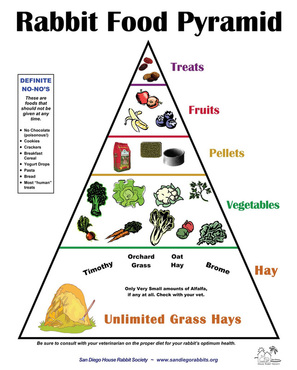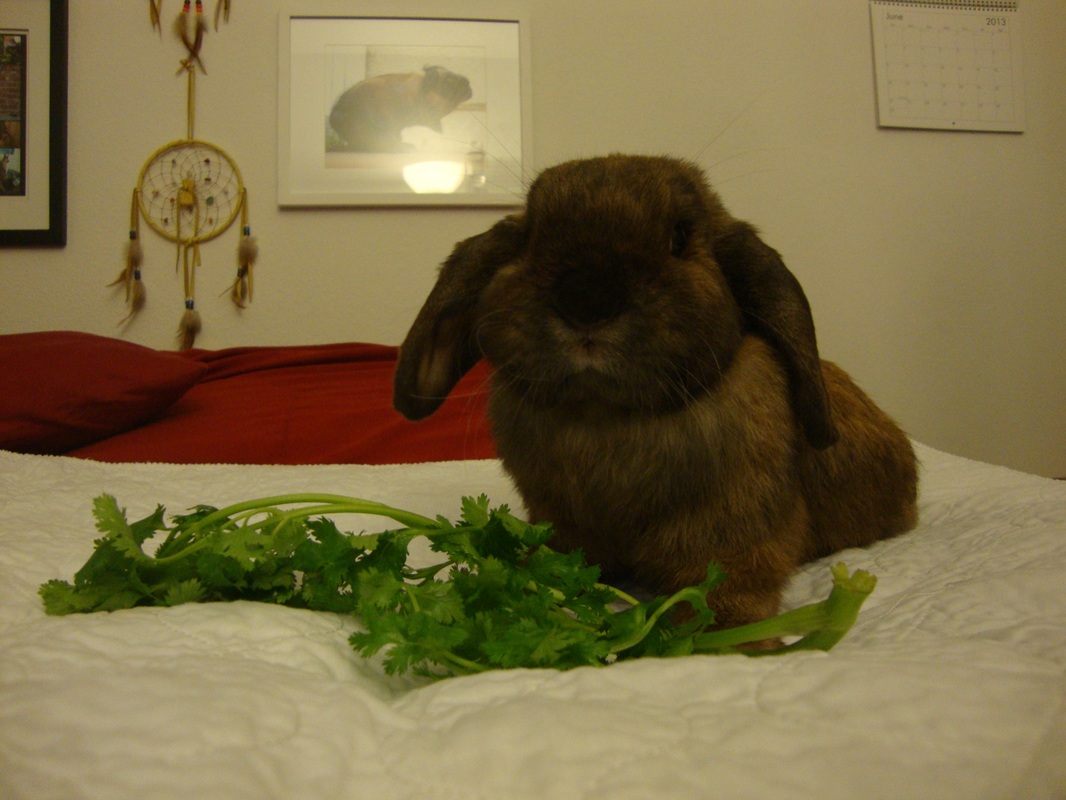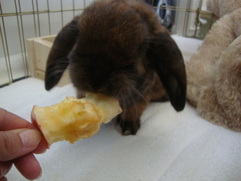Fresh Foods (Vegetables & Fruits)Fresh foods and their role for your disabled rabbit.
As a general rule, your rabbit's fresh food diet should be made up of:
|
Vegetables
Vegetables and their role for your disabled rabbit.
While hay should be the foundation of all rabbit diets and the primary source of vitamins, fiber, calcium and other nutrients, fresh foods are the next most important part of your rabbit's diet. Fresh vegetables provide additional nutrients and serve to create a balanced diet made up of different textures and tastes. Vegetables are also an important source of moisture, which is important for bladder and kidney health. For a disabled rabbit, moisture and fresh nutrients are critical for health and thus vegetables should not be an overlooked part of their diet.
When introducing any new vegetables, go slowly. Start with small amounts and give your rabbit time to adjust before you feed any vegetables in larger quantities. Also, be sure that your rabbit has been eating grass hay for a minimum of 2 weeks before you introduce them to any vegetables.
Here are the age guidelines for feeding vegetables:
When introducing any new vegetables, go slowly. Start with small amounts and give your rabbit time to adjust before you feed any vegetables in larger quantities. Also, be sure that your rabbit has been eating grass hay for a minimum of 2 weeks before you introduce them to any vegetables.
Here are the age guidelines for feeding vegetables:
- 12 weeks = introduce vegetables one at a time in very small quantities
- 7 months to 1 year = increase daily vegetables gradually
- 1 year to 5 years = feed a minimum of 2 cups of packed vegetables per 6 pounds of body weight
- 6 years and up = continue adult diet
Rabbit-Safe Vegetables
Fresh vegetables are made up of both leafy vegetables and non-leafy vegetables. There are a number of different fresh vegetables of both varieties to choose from, each with its own taste and texture. Try to find the ones that your rabbit likes the most.
Leafy Greens
Your rabbit should be eating approximately 1 cup of packed leafy greens per 2 pounds of body weight once per day.
|
*need to be used in small amounts and/or rotated due to oxalic acid content
*use only one of these types of veggies per day
*use only one of these types of veggies per day
Non-Leafy Vegetables
Your rabbit should be eating approximately 1 tablespoon of non-leafy vegetables per 2 pounds of body weight once per day.
- Asparagus
- Bell peppers - any color
- Broccoli - leaves, stems and floretes
- Broccolini
- Brussels sprouts - leaves and sprouts
- Cabbage - any type, can sometimes cause digestive upset
- Carrots
- Cauliflower - leaves, stems and floretes
- Celeriac
- Celery - leaves and stalks
- Chicory
- Chinese pea pods - the flat kind without large peas (no green beans)
- Cucumber - good for moisture
- Edible flowers (roses, nasturtiums, pansies, hibiscus)
- Kohlrabi
- Mushrooms (any cultivated type)
- Parsnip
- Pumpkin - great for digestion, don't feed seeds
- Summer squash - butternut, etc., don't feed seeds
- Zucchini squash
Fruits make up a small portion of available fresh foods for rabbits and are a sweet treat that most (if not all) rabbits enjoy. They are great in taste, texture, moisture and vitamins and minerals. However, fruits must be fed carefully. Fruits are high calorie, high sugar foods that, in the wild, rabbits would only find on a special occasion. Rabbits will naturally gravitate towards these sweet tasty treats over other foods, but they do tend to lead to excess sugar and calories, weight gain and can potentially lead to gastrointestinal upset. In disabled rabbits though, weight gain may be a good thing. Just monitor their intake carefully and do not feed much more than is recommended so as to avoid too much sugar. Watch their droppings for signs of any digestive upset caused by too much sugar and be sure they are eating enough hay.
When introducing any new fruits, go slowly. Start with small amounts and give your rabbit time to adjust before you feed any fruits in larger quantities. Also, be sure that your rabbit has been eating grass hay for a minimum of 2 weeks before you introduce them to any fruits.
Here are the age guidelines for feeding fruits:
When introducing any new fruits, go slowly. Start with small amounts and give your rabbit time to adjust before you feed any fruits in larger quantities. Also, be sure that your rabbit has been eating grass hay for a minimum of 2 weeks before you introduce them to any fruits.
Here are the age guidelines for feeding fruits:
- 12 weeks = introduce fruits one at a time in very small quantities
- 7 months to 1 year = increase daily fruits gradually; no more than 1 to 2 ounces per 6 pounds of body weight
- 1 year to 5 years = feed no more than 2 ounces per 6 pounds of body weight
- 6 years and up = continue adult diet if weight is maintained; decrease fruits if weight increases
Rabbit-Safe Fruits
Your rabbit should be eating approximately 1 teaspoon per 2 pounds of body weight once per day.
*Always remove any pits or seeds
- Apple - any type
- Apricot
- Banana - remove peel, feed sparingly, high in potassium
- Berries - any type including blackberries, blueberries, raspberries, and strawberries, uncooked
- Cherries - any type
- Currants
- Grapes
- Kiwi - remove skin
- Mango
- Melon - any type
- Nectarine
- Orange - remove peel, not too much
- Papaya - great for digestion
- Peach
- Pear
- Pineapple - remove skin
- Plum
- Star Fruit
*Always remove any pits or seeds




